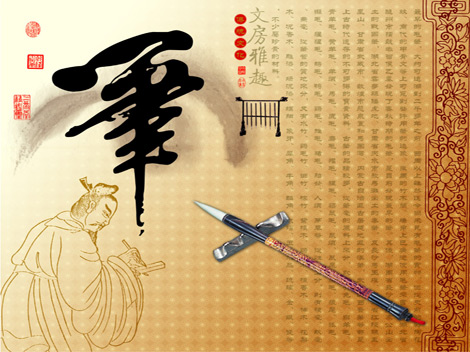Posted 2017/8/28
The Chinese ink brush is made of goat’s hair, rabbit hair or the tail hairs of weasel. Such a brush is soft and has good elasticity. Soaked in ink, it has what is known as “capillarity”, which combined with the strong ink permeability of a special Chinese paper, making the strokes in a calligraphic work more vivid, varied and pretty.

The use of the Chinese ink brush can be traced back 6,000 years. In the early years, the brush was very simple. It seems that the picture, symbols and characters on ancient pottery, painted in red and black, were done with brush strokes.
The earliest brush intact today was found in a fifth century BC tomb of the State of Chu in 1958. A large number of inscriptions on bamboo strips were unearthed at the same time.
In the fourth century, the skill of brush making saw great progress. The Chinese ink brush became more suitable for calligraphers to bring their skill into full play. It had four features, summed up as follows: first, the tip of the brush could display the delicate changes of strokes. Second, its smooth end hair could make writing vigorous while it spread across the paper. Third, its cone shape made it easy to move in all directions. Fourth, it was durable, and kept is elasticity and softness longer. With such a brush, the calligrapher could write characters in different shapes, displaying different intensities and rhythms. Using different thicknesses of ink, the characters become three-dimensional.
The brushes from Anhui, Jiangsu, Jiangxi and Henan provinces are the most famous in the country. The biggest one was made by a factory in Tianjin in 1979. It is 157 cm long including the 20-cm long hair end, and it weighs five kg. It can soak up one kg of ink. On the morning of September 14, 1979, calligrapher Yang Xuanting from Beijing wrote four characters meaning “Long Live the Motherland” on a piece Xuan paper 100 cm long and 150cm wide with this brush to mark the 30th anniversary of the founding of the People’s Republic of China.
Size: Generally classified as either big (大楷), medium (中楷) or small (小楷); most calligraphy is written with a medium-sized brush. The smallest brushes are used for very small pieces and for fashioning designs for seals. Medium brushes are the most widely used; wielded by a skilled artist, a medium brush can produce a variety of thicknesses of line, from very thin to fairly thick. The largest brushes are used only for very large pieces.
Texture: Either soft (软毫), mixed (兼毫) or hard (硬毫). Certain textures are better for writing certain styles than others are.